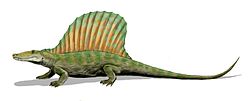| Melanedaphodon Temporal range: Late Carboniferous, Moscovian | |
|---|---|
 | |
| Holotype specimen | |
| Scientific classification | |
| Domain: | Eukaryota |
| Kingdom: | Animalia |
| Phylum: | Chordata |
| Clade: | Synapsida |
| Clade: | Sphenacomorpha |
| Family: | † Edaphosauridae |
| Genus: | † Melanedaphodon Mann et al., 2023 |
| Type species | |
| †Melanedaphodon hovaneci Mann et al., 2023 | |
Melanedaphodon (meaning "black pavement tooth") is a genus of edaphosaurid synapsids that lived in North America during the Late Carboniferous epoch, during the Moscovian stage. The genus contains the type species, Melanedaphodon hovaneci, named and described in 2023 based on the holotype specimen hailing from the Allegheny Group. Several of the anatomical traits of Melanedaphodon are interpreted as suited for omnivory and low-fibre herbivory. [1]






